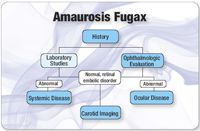Watch for carotid artery disease signs, symptoms
The prevalence of carotid artery disease – one of the leading causes of ischemic stroke – increases with advancing age.

Key Points


The two strongest predictors of CAD are age and male sex. Other risk factors include high systolic blood pressure, cigarette smoking, increased serum fibrinogen levels, elevated cholesterol levels, and history of diabetes mellitus or CAD.
"When associated with atherosclerosis, amaurosis fugax can be a symptom preceding more devastating or lasting ocular conditions, such as anterior ischemic optic neuropathy, retinal arterial occlusions, or central retinal vein occlusion," Dr. Lim said. "Sometimes, amaurosis fugax can be that red flag to the onset of brain stem or vestibular-basilar insufficiency, especially when amaurosis presents binocularly and simultaneously."
Because amaurosis fugax can be a precursor to stroke or life-threatening conditions, the workup to determine the proper cause should be instituted right away. The Amaurosis Fugax Study Group has developed an algorithm that begins with a thorough history of when the amaurosis occurred and in which eye. If patients are in a high-risk group or fit the clinical profile in which giant cell arteritis must be ruled out, they should receive appropriate laboratory studies.
An eye-care professional (ECP) also should be part of the co-management team, along with the patient's internist, cardiologist, neurologist, and vascular surgeon, Dr. Lim said.
During the ophthalmologic evaluation, the ECP looks for normal and abnormal signs. If ocular disease, such as arterial or vein occlusions, are present and the cause is unclear, systemic imaging studies of the carotid or the heart or neuroimaging of the brain should be ordered.
Retinal embolism can also occur. These emboli usually originate from larger blood vessels, and ECPs are most likely to encounter cholesterol, fibrin-platelet, calcium, or talc emboli.
Distinguishing between these is important, said Dr. Lim. For example, Hollenhorst plaques, made up of cholesterol crystals, tend not to compromise retinal circulation and are found routinely on fundoscopic examinations. Fibrin-platelet emboli can, however, fill the entire lumen of the blood vessel and have a higher chance of causing retinal dysfunction and retinal artery occlusion. They are less easily seen during fundoscopic examinations.
Retinal arterial occlusions are almost inevitable when emboli enter the retinal circulation; retinal emboli are associated with a higher risk of stroke-related deaths. Fortunately, most retinal infarctions are not acutely associated with cerebral infarctions, seemingly because the emboli that lodge in retinal blood vessels tend to be smaller than the ones that would cause cerebral ischemia, Dr. Lim said.
Newsletter
Want more insights like this? Subscribe to Optometry Times and get clinical pearls and practice tips delivered straight to your inbox.